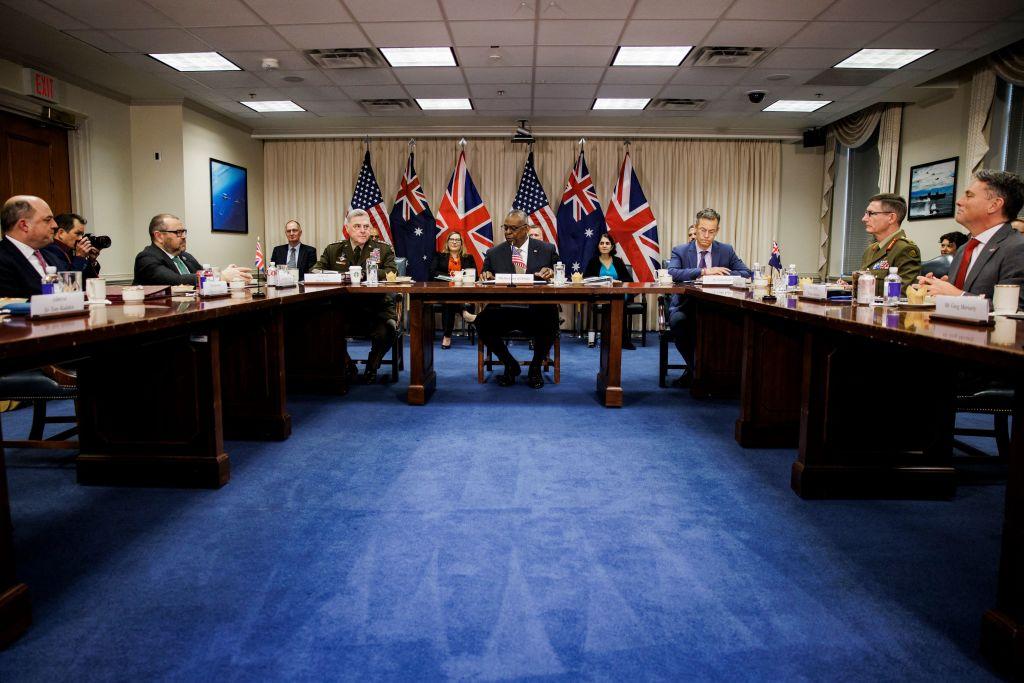Will AUKUS policy penetrate defence bureaucracies?
Posted By Bob Moyse on June 14, 2023 @ 15:00

Policy is a statement of intent or ambition. It is only effective to the extent that it penetrates the practices and mindset of the bureaucracy responsible for implementing it. Bureaucracies in general and defence bureaucracies in particular are famously resilient to policy. Australian defence policy has evolved considerably in the past three decades, but you wouldn’t guess it from the force structure. In the case of AUKUS, policy must penetrate three separate defence bureaucracies if it is to succeed. A recent story gives little cause for optimism.
When AUKUS was announced in September 2021, the US Department of Defense said that it would ‘promote deeper information sharing and technology sharing; and foster deeper integration of security and defense-related science, technology, industrial bases and supply chains’.
Australia and the UK made similar pronouncements. Twenty months later, on 17 May, the US Department of Defense released a request for information [1] (RFI) for the design and construction of the US Navy’s mid-sized landing craft (the Landing Ship Medium (LSM); formerly the Light Amphibious Warship (LAW)). This program is an essential component of ‘expeditionary advanced base operations’ (EABO), the US Marine Corps’ concept for supporting the US Navy within the umbrella of the Chinese military’s anti-access and area-denial (A2/AD) capabilities. The corps’ restructure to marine littoral regiments leaves it unbalanced until it gets its LSM fleet, up to 35 of them. They are needed in service urgently.
US policy documents about EABO are liberally sprinkled with pictures of the world’s only in-service, in-production stern landing vessel (SLV). It is attractive to the marines because it can operate in sea conditions that would halt operations with conventional landing craft, if not sink them, and has class-leading payload and range. It’s cheap and quick to build and has the highest damage stability index of any landing ship ever built, capable of exceeding even the US Navy’s warship requirements.
It is also effectively excluded from the LSM RFI. The SLV is Australian and the RFI pack is only accessible to US shipyards and US ship designers. The US defense bureaucracy does this from habit rather than regulations, rather like stamping Five Eyes–sourced documents NOFORN (‘no foreign nationals). Title X, US Code 8679 requires all vessels for the US armed services to be built by American companies. It does not require that those companies build US designs. US submarines use propulsors based on a British design. The US Marine Corps’ M777 and M119 howitzers and M252 mortars are British designs. The list goes on. The SLV designer made provisional arrangements with US shipyards for US construction as long ago as 2019, but that doesn’t help them if they’re not allowed to see the RFI.
A US-only RFI may or may not conflict with the spirit of AUKUS, but it definitely ignores the lessons of its failed predecessor, the LAW. In four years, that project produced little of value, other than proving that converting an offshore support vessel into a (sort of) SLV is not a good idea. In the current strategic environment, the LSM project doesn’t have another four years to waste, yet it appears to be plodding on with the same process-driven pedestrian approach that the LAW program suffered from.
As well as wasting time, this approach also appears to be at risk of wasting money. The US Navy’s fiscal year 2024 budget request seeks US$14.7 million for research and development, then US$187.9 million for procurement of the first LSM in 2025. Construction of the latest Australian-designed SLV is currently being completed in Asia. It’s likely to sell commercially for US$22–25 million, plus inflation, but there is much to add to that to get a military price. The cost of bringing it to US Navy survivability standards would be small, but weapons, sensors and command and control systems probably make up the bulk of the cost. There’s an administration overhead of at least 30% for meeting the Pentagon’s bureaucratic requirements. Finally, there’s a cost for requiring it to be built in the US. Notwithstanding all that, it’s difficult to see how a US$22–25 million commercial ‘sticker price’ could get up to US$187.9 million for LSM No 1.
The reason all in-service commercial SLVs are designed and built by one company isn’t that others haven’t tried. It’s because they haven’t succeeded. It is very difficult to design these vessels so they work properly, as the LAW project found out with its recent offshore support vessel conversion. There’s no logical reason to expect that a company that has never done it before will get it right the first time when no one else ever has, but that seems to be the premise of the LSM project strategy.
If Australia and the US can’t make use of each other’s simple but successful technologies, what chance is there for the more complex ones? More to the point, though, is whether the US bureaucracy is actually capable of evolving post-AUKUS to ‘promote deeper information sharing and technology sharing; and foster deeper integration of security and defense-related science, technology, industrial bases and supply chains’, or whether it will remain the same old creature of habit.
Article printed from The Strategist: https://aspistrategist.ru
URL to article: /will-aukus-policy-penetrate-defence-bureaucracies/
URLs in this post:
[1] request for information: https://www.highergov.com/contract-opportunity/medium-landing-ship-lsm-detail-design-and-constr-n00024-23-r-2469-r-0b57c/
Click here to print.